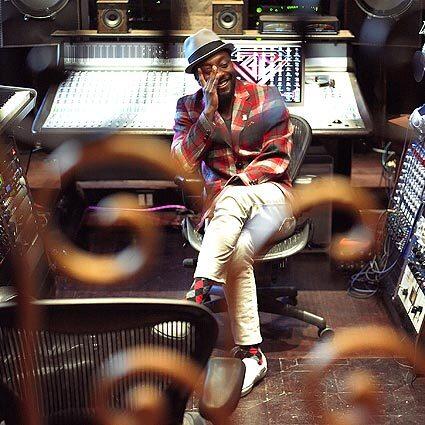.
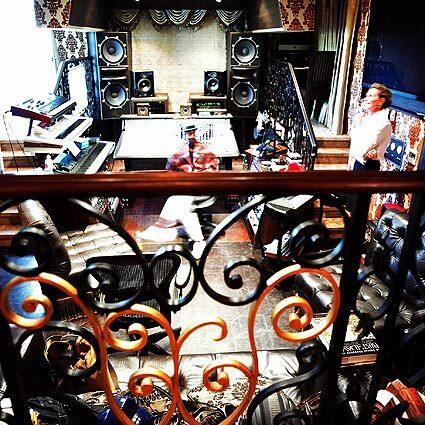
“Unless something is physically impossible, will doesn’t understand the words ‘it can’t be done,’ ” says designer Reid, standing on one of her custom-designed leather sofas in the control room.
To that end, when the artist asked for higher ceilings, Reid consulted with acoustic architect Vincent Van Haaff of Waterland Design, who built the studio. Contractors dug out a new foundation under the floors, which Reid then covered in Brazilian cherry planks with an inset leather rug.
Reid also covered the control console in leather and set it on carved wooden lion’s paw feet. Behind the stacks of speakers, a motorized Roman shade covers a double-paned window. “Will really likes to blast it loud,” she says. “We sealed this place up and you can still hear it on the street.” (Bob Chamberlin / Los Angeles Times)
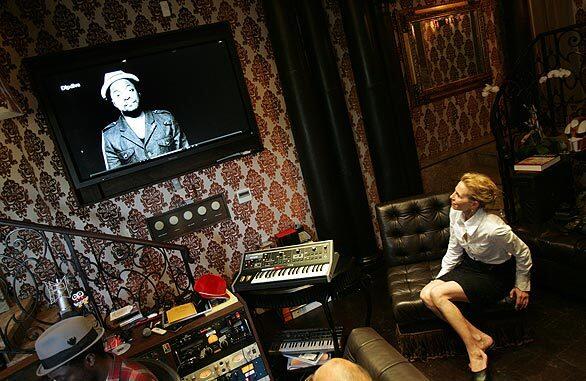
From the comfort of a fringed slipper chair in a 1940s French modern style, Reid watches the “Yes We Can” video. Created in this room, the clip has received nearly 20 million views on Youtube and another 15 million on Dipdive, a site that will.i.am developed.
Beneath the widescreen TV, mounted on a fabric-covered wall, a group of rheostats control the lighting for the room.
“You have to use special low-voltage bulbs that don’t buzz or hum,” Reid says. (Bob Chamberlin / Los Angeles Times)
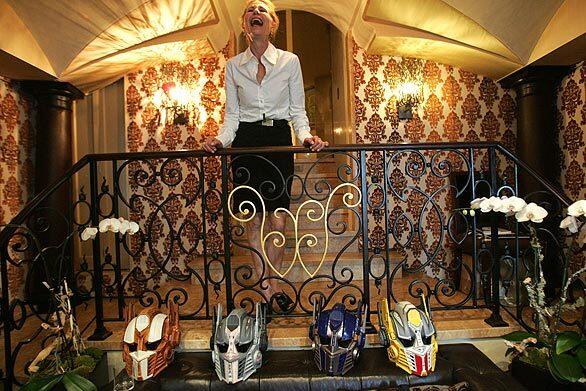
Reid, a former singer, demonstrates the balanced acoustics of the room, which has a groin vault ceiling similar to those found in Romanesque and Gothic cathedrals.
“Everything in the room has to be balanced for sound refraction and absorption,” she says of the symmetrical design, which includes two stairways leading from the landing and leather wrapped columns in each corner to baffle sound. (Even the orchids are symmetrically placed.)
The railing by Mastercraft Iron incorporates will.i.am’s initial in gold leaf. Below it, his collection of Transformer helmets sits on top of a leather sofa. (Bob Chamberlin / Los Angeles Times)

Hollywood sconces by Dutch lighting firm Brand Van Egmond flank the entry of the control room, casting shadows on the ceiling that echo the patterned raised-velvet covered walls.
“It’s an earthy art piece, like a bronzed version of a tree,” Reid says of the fixture. “And will is moved by natural materials.” (Bob Chamberlin / Los Angeles Times)

The studio is accessible from a winding travertine stairway in the main house. On their way in, visitors pass this mash-up portrait of Barack Obama and Abraham Lincoln, titled “Abraham Obama,” part of an edition of 10 in Gold Diamond Dust by Ron English. (Bob Chamberlin / Los Angeles Times)

The stairway leads to a rotunda with a mixed-stone floor that Reid designed as an Old World compass, which incorporates will.i.am’s owl-accented monogram logo. The piece was crafted by stone and tile retailer Walker Zanger and includes limestone, walnut travertine and black granite. It cost around $8,000, including installation by C.G. Custom Tile & Marble.
“I sensed that will was into funky classics made with fresh materials,” Reid says, “that he wanted things to look like they might’ve been original to the house.” (Bob Chamberlin / Los Angeles Times)

As a creator of the Black Eyed Peas’ chart-topping, beat-driven tunes, will.i.am knows his way around the snares and cymbals. Here, he taps out a rhythm in the studio’s drum booth, which has a sliding glass door and walls upholstered in raised velvet from Diamond Foam and Fabric. “It’s a high-end version of flocked wallpaper,” Reid says.
Inspired by luxury hotels in London and Paris, he says his studio looks European, but fresh: “I am not into boxes with cement floors and square couches. People say, ‘Wow, check this out, it’s contemporary.’ I say, ‘Wow, this looks unfinished.’ ” (Bob Chamberlin / Los Angeles Times)

Across the hall in the vocal booth, Reid inspects the felt lining of Silk Trading Co. draperies that can be drawn to soften sound in the room.
“It’s a new take on an old idea,” she says of the ornate fabrics. “Henry VIII would love it here.” (Bob Chamberlin / Los Angeles Times)

“It’s a bordello look,” Reid says of the guest powder room in the studio complex. “Pimped-out, but elegantly.”
In addition to a black toilet, the plumbing includes a sculpted black granite Stone Forest sink purchased online at Luxury Home Products. The faucet and towel ring are from Newport Brass.
Flocked wallpaper from Astek gives the tiny room a sense of grandeur, as does the gilded Arts and Crafts style mirror, a gift from Reid. (Bob Chamberlin / Los Angeles Times)
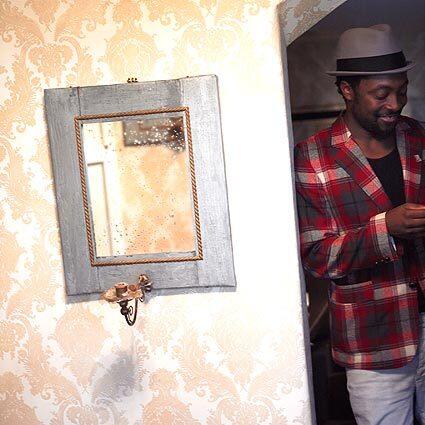
“After seeing the movie ‘Horton Hears a Who,’ I called Liana and told her that’s what I wanted to do with this space,” says will.i.am, in the doorway of a room that separates the studio from the lounge.
“He actually called me from the store, Bourgeois Boheme, where he found a half dozen of these mirrors,” Reid adds. “He’s very active and very opinionated in the design process. His fearlessness about trying things made the job so much more collaborative and creative.” (Bob Chamberlin / Los Angeles Times)

Continuing the damask motif theme created by the upholstered walls in the studio and powder room, the wallpaper in the lounge was used to give the refrigerator a face-lift. Even the handle got a makeover with a vintage door pull from Liz’s Antique Hardware. (Bob Chamberlin / Los Angeles Times)
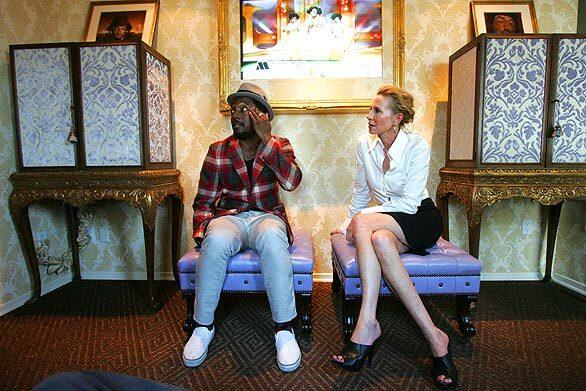
The lounge observes the rule of symmetry that Reid established in the control room. Here, she tricked out a pair of antique consoles that had 20th century hutches added to them, with lavender raised-velvet upholstery. Similarly, the flat screen TV sits in a silk matte and a custom frame made by McConnells Hand Crafted on Melorse Avenue.
Though it appears luxurious, the carpeting is actually a diamond-patterned sisal in chocolate brown from Contempo Floor Coverings. (Bob Chamberlin / Los Angeles Times)
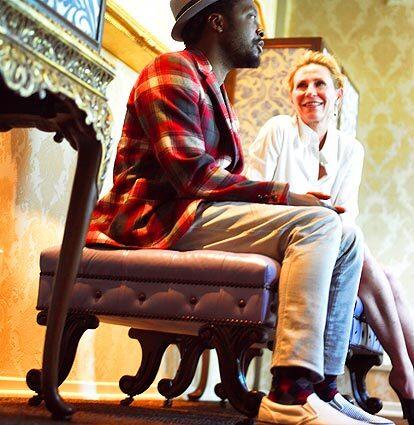
The musician and the designer sit on matching ottomans that fit under the ornate cabinets. Reid designed the seats in a Victorian style with carved walnut legs and brass casters, tufting and nailhead trim.
Can that be lavender leather? Yes it can.
“It was will’s idea,” Reid says, “and he also chose pale pink paint for the ceiling. The man is not intimidated by color.” (Bob Chamberlin / Los Angeles Times)
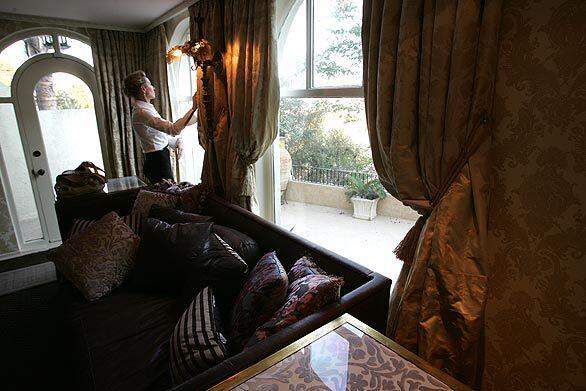
Arched Spanish windows and doors let in more than enough sunshine in the lounge, so Reid designed the elaborate drapery with blackout panels so guests can watch TV.
“It’s very ‘The Tudors,’ ” she says of the decor, “but this is more like the maiden’s boudoir.”
The couch was “so deep, I had to take its legs off and the door off its hinges to get in the room,” Reid adds. It’s deep enough for napping and flanked by tables that have storage shelves for video games, remote controls and trays for snacking. (Bob Chamberlin / Los Angeles Times)

Reid’s aim was to create an environment that reflects will.i.am’s musical sensibility.
“When you listen to his work, you instantly get a good feeling and you’re not sure why until you start to listen to the details,” she says. “I approached these rooms the same way: It’s not like any one particular element screams out at you. It’s the combination of the details.”
A case in point: This close-up of one of Reid’s custom tables shows leather sides decorated with nailheads in a diamond pattern that coordinates with the carpeting. The top has a gold-leaf edge with raised velvet fabric under glass, as though it were a framed textile converted into a counter surface. (Bob Chamberlin / Los Angeles Times)

A vintage Fender Rhodes electric keyboard that was used on the road by the Black Eyed Peas also got the Reid treatment with leather and nailhead upholstery and carved claw and ball feet. (Bob Chamberlin / Los Angeles Times)

At Villa Melrose Antiques, Reid bought a set of dining chairs by Rose Tarlow, who designs exuberant updates of traditional period furnishings. For will.i.am, Reid recovered them in velvet that was ironed (creating a high-luster finish known as panne) and screen-printed with his logo in a repeat pattern a la Louis Vuitton. (Bob Chamberlin / Los Angeles Times)

The “i-am-aphone,” a collaborative sculpture by will.i.am and Reid, is a modernist gramophone made from an old tuba and a modern turntable set into an onyx case illuminated by interior lights.
“Will is boundless in his creativity,” Reid says. “Everything is like a crazy art project.” (Bob Chamberlin / Los Angeles Times)
